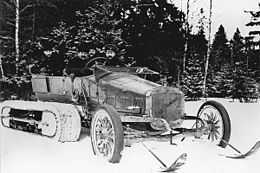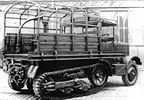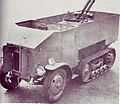Kégresse track
A Kégresse track is a kind of rubber or canvas continuous track which uses a flexible belt rather than interlocking metal segments. It can be fitted to a conventional car or truck to turn it into a half-track, suitable for use over rough or soft ground. Conventional front wheels and steering are used, although skis may also be fitted. A snowmobile is a smaller ski-only type.

Technology
The Kégresse propulsion and suspension system incorporates an articulated bogie, fitted to the rear of the vehicle with a large drive wheel at one end, a large unpowered idler wheel at the other and several small guide wheels in between, over which run a reinforced flexible belt. The belt is fitted with metal or rubber treads to grip the ground. It differs from conventional track systems by using a flexible belt rather than interlocking metal segments.
Use in Russia
The name comes from the system's inventor Adolphe Kégresse, who designed the original while working for Tsar Nicholas II of Russia between 1906 and 1916. He applied it to several cars in the Royal garage including Rolls-Royce cars and Packard trucks. The Russian army also fitted the system to a number of their Austin Armoured Cars.
-

Patent drawing of Kegresse half-track CH65643 (1913)
-

Russian imperial state limousine (a 1916 Packard Twin-6 touring car) equipped with Kegresse track (1917)
-

-

-

-

An Austin-Putilov Armoured Car of the Red Army which was damaged during the Polish–Soviet War. In the area of Zhytomyr, 21 March 1920.
-

Lenin's Rolls-Royce Silver Ghost with Kegresse track, converted by the Putilov plant, at Gorki Leninskiye
Further Development in France
After the Russian Revolution Adolphe Kégresse returned to his native country, France, where the system was used on Citroën cars between 1921 and 1937 for off-road and military vehicles. A series of Expeditions across the undeveloped parts of Asia, America and Africa was undertaken by Citroën, demonstrating the all-terrain capabilities of these vehicles.
-

Patent drawing of Kegresse system FR597142 (1924)
-

Citroën Kégresse in the Marxzell Museum, Germany
-

A 1931 C4 based Citroën P19B Kégresse halftrack
-

Track System of a 1931 C4 based Citroën P19B Kégresse halftrack
-
.jpg)
A 1933 C4 based Citroën P17 C Kégresse halftrack
-
.jpg)
Track System of a 1933 C4 based Citroën P17 C Kégresse halftrack
-
.jpg)
Detail of Track System of a 1933 C4 based Citroën P17 C Kégresse halftrack
-
A Unic-Kegresse P107 at the Musée des Blindés, France.
-
A Unic-Kegresse P107 halftrack that was captured and used by the Wehrmacht, displayed in the Museum of the Great Patriotic War, Moscow, Poklonnaya Hill Victory Park
-
Tracks of a Unic-Kegresse P107 halftrack that was captured and used by the Wehrmacht, displayed in the Museum of the Great Patriotic War, Moscow, Poklonnaya Hill Victory Park
-

French experimental semi-tracked armoured car Peugeot-Kégresse during testing in 1923.
-

French medium half-track SOMUA MCL-5, in 1939
-
SOMUA MCL6 heavy artillery tractor Fort de Fermont museum
-

SOMUA MCG with PaK 40 in north Italy.
-

Armoured SOMUA MCG modified by Alfred Becker for use by the Wehrmacht
Use in Great Britain
An 30cwt armored personnel carrier called "Burford-Kegress" was built by the British firm Burford produced on the basis of its four-axle trucks with wheel formula 4 × 2: It was equipped with Rear Axle mover Kegresse tracks produced under license from the French company Citroën. Released in 1926 prototype machine has successfully passed trials, the results of which was positively received by the military, and in the same year Burford commissioned by the British Army to build a small batch.
Despite the success of the test, as a result of continuous operation it was discovered that the Kegresse had an extremely low wear resistance, and often broke down. As a result, in 1929, only three years after its creation, the machines were taken out of service and later scrapped.
-

British semi-tracked armoured personnel carrier Burford-Kegresse 30cwt.
-

-

-

-

Use in Poland
Citroën-Kegresse vehicles served in the Polish motorized artillery during the 1930s.[1]
Use in Belgium
The FN-Kégresse 3T was a half-track vehicle used by the Belgian armed forces as an artillery tractor between 1934-1940. 130 FN Kégresse 3T's were built, with some 100 actually in use with the Belgian armed forces on 10 May 1940, the start of the battle of Belgium.
Use in the United States
In the late 1920s the U.S. Army purchased several Citroën-Kégresse vehicles for evaluation followed by a licence to produce them. This resulted in the Army Ordnance Department building a prototype in 1939. In December 1942 it went into production with the M2 and M3 half-track versions. The United States eventually produced more than 41,000 vehicles in over 70 versions between 1940 and 1944.
Gallery
-

Experimental Kégresse track on Convair XB-36 Peacemaker
-

Cuthbertson drive fitted to a Land Rover
See also
Sources
- ↑ Derela, Michał (2001). "Citroën-Kegresse halftracks in Polish Service". PIBWL. Retrieved 2013-07-05.




